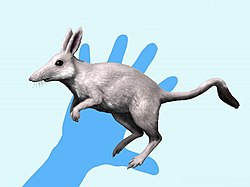| Peradectidae Temporal range: | |
|---|---|
 | |
| Fossil of Peradectes | |
 | |
| Life restoration of Mimoperadectes | |
| Scientific classification | |
| Domain: | Eukaryota |
| Kingdom: | Animalia |
| Phylum: | Chordata |
| Class: | Mammalia |
| Clade: | Metatheria |
| Family: | † Peradectidae Crochet, 1979 |
| Genera | |
Peradectidae is a family of small metatherian mammals, spanning from the Paleocene (or possibly Latest Cretaceous) to the Miocene. Fossils are known from the Northern Hemisphere, including Europe, Asia and North America. The monophyly of the group has been questioned, with some authors suggesting that Peradectes should be the only genus placed in the family. [1] The morphology of peradectids has been considered to be similar to opossums, [2] with at least some exhibiting morphology suggesting a tree dwelling arboreal/scansorial lifestyle. [3] Their diet is suggested to have included insects and fruit. [4]
Phylogenetic analysis suggest that they are less closely related to modern marsupials than herpetotheriids are. [5]
Cladogram after: [2]
| Metatheria | |




